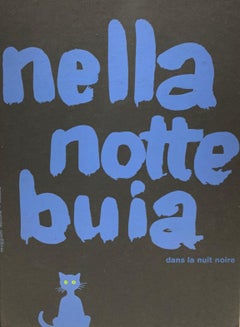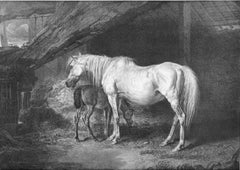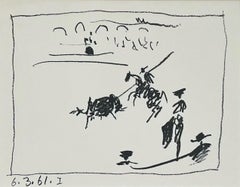Bruno Munari Animal Prints
Italian, 1907-1998
In his prolific career, Bruno Munari was known for various contributions to art, industrial design, film, architecture, art theory, and technology. Munari’s principles and beliefs were built upon his early involvement in the Futurist movement, which he joined at the age of 19 using the pseudonym “Bum.” During the 1930s, Munari began to move towards Constructivism, particularly with his kinetic sculptures, Useless Machines (begun 1933), meant to transform or complicate their surrounding environments. Throughout his career, Munari was captivated by both a sense of whimsy and the manipulation of artificial light. After World War II, Munari also developed radical innovation in graphics, typography, and book publishing, through the latter creating pieces he would call Useless Books.to
1
1
Overall Width
to
Overall Height
to
24
196
162
101
96
1
1
1
1
Artist: Bruno Munari
Nella Notte Buia / dans la nuit noire
By Bruno Munari
Located in Wilton, CT
Children’s book by Italian graphic designer and Futurist, Bruno Munari. Fun book features pochoir-colored pages with cut outs, wax pages with color illustrations, and tipped in secti...
Category
1950s Futurist Bruno Munari Animal Prints
Materials
Other Medium
$720 Sale Price
20% Off
Related Items
Primrose and Foal: A Brood-Mare, late the Property of his Grace the Duke of Graf
By James Ward
Located in Boston, MA
From Celebrated Horses, Grundy 24. A fine chine applique impression in fine condition with full margins. A proof before letters. Exhibited at the...
Category
19th Century Romantic Bruno Munari Animal Prints
Materials
Lithograph
$3,500
H 13.25 in W 17.75 in
La Pique (I), from A Los Toros Avec Picasso
By Pablo Picasso
Located in Washington, DC
Artist: Pablo Picasso
Title: La Pique (I)
Portfolio: A Los Toros Avec Picasso
Medium: Transfer lithograph
Date: 1961
Frame Size: 17 1/4" x 19 3/4"
Sheet Size: 9 1/2" x 12 1/2"
Image ...
Category
1960s Abstract Bruno Munari Animal Prints
Materials
Lithograph
Original Italian Emidio di Nola Italian Macaroni original vintage food poster
Located in Spokane, WA
Emidio di Nola, original Italian pasta poster. Size 19" x 25.5". Professional acid-free archival linen-backed; in excellent condition; ready to frame....
Category
1950s Aesthetic Movement Bruno Munari Animal Prints
Materials
Lithograph
$750
H 25.5 in W 19 in D 0.05 in
CRISALIDA
By José María Mijares
Located in Aventura, FL
Hand signed, titled, dated, and numbered in pencil by the artist. Edition of 100. Frame size: 40 x 32.75 inches. Artwork is in excellent condition. Certificate of authenticity inc...
Category
1980s Contemporary Bruno Munari Animal Prints
Materials
Lithograph, Paper
NIGHT ANIMAL Signed Lithograph, Abstract Cat, Color Stripes Pink Yellow Red Blue
By Karel Appel
Located in Union City, NJ
NIGHT ANIMAL is an original limited edition lithograph by the Dutch artist Karel Appel on printed using traditional hand lithography techniques on archival printmaking paper, 100% ac...
Category
1970s Abstract Bruno Munari Animal Prints
Materials
Lithograph
$1,590
H 21.5 in W 29.5 in
"Old World" 60x40 Black & White Photography Bison Buffalo Signed Photograph
By Shane Russeck
Located in Los Angeles, CA
This is a contemporary photograph of an American Bison.
Printed on archival paper and using archival inks
Framing available. Inquire for rates.
Signed edition of 10
Shane Russeck...
Category
21st Century and Contemporary Bruno Munari Animal Prints
Materials
Archival Pigment
$1,550
H 60 in W 40 in D 0.5 in
"On The Waterfront" 36x48 Black & White Photography Kodiak Grizzly Bear Signed
By Shane Russeck
Located in Los Angeles, CA
This is a contemporary photograph of a Kodiak Bear.
This was shot on Kodiak Island in 2019.
36x48 Edition of 12
Singed and numbered
Archival pigment paper
Framing available. Inqui...
Category
21st Century and Contemporary Bruno Munari Animal Prints
Materials
Archival Pigment
$1,475
H 36 in W 48 in D 0.1 in
40x60 Photography of Wild Horses Mustangs Color Photograph 1STDIBS EXCLUSIVE
By Shane Russeck
Located in Los Angeles, CA
This is a contemporary color photograph of Northern California Wild Mustangs.
THIS COLOR IMAGE IS A 1STDIBS EXCLUSIVE
"They represent the ultimate expression of American freedom"
40...
Category
21st Century and Contemporary Bruno Munari Animal Prints
Materials
Archival Pigment
64x48 Color Lion Photography Print "Panthera Leo" Photograph 1stDibs Exclusive
By Shane Russeck
Located in Los Angeles, CA
This is a contemporary photograph of an African Lion shot by Shane Russeck
Thsi is a color uncropped version of Panthera Lea.
1stDibs Exclusive
64x48
Unsigned Edition
Printed on Ar...
Category
21st Century and Contemporary Bruno Munari Animal Prints
Materials
Archival Pigment
$1,560 Sale Price
20% Off
H 64 in W 48 in
48x36 Color Lion Photography Print "Panthera Leo" 1stDibs Exclusive Unsinged
By Shane Russeck
Located in Los Angeles, CA
This is a contemporary photograph of an African Lion shot by Shane Russeck
Thsi is a color uncropped version of Panthera Lea.
1stDibs Exclusive
Unsigned Edition
Printed on Archival...
Category
21st Century and Contemporary Bruno Munari Animal Prints
Materials
Archival Pigment
$760 Sale Price
20% Off
H 48 in W 36 in
"Mountain Mustangs" 36x48 Photography of Wild Horses, Mustangs Horse Fine Art
By Shane Russeck
Located in Los Angeles, CA
This is a contemporary photograph of wild horses.
"They represent the ultimate expression of American freedom"
36x48 Edition of 12
Printed on archival photo paper using only archi...
Category
21st Century and Contemporary Bruno Munari Animal Prints
Materials
Archival Pigment
$1,250
H 36 in W 48 in D 0.1 in
Bear Beach - 48x36 Black & White Photography, Brown, Grizzly Bear Unsigned
By Shane Russeck
Located in Los Angeles, CA
This is a contemporary photograph of a Brown Bear.
This was shot on Kodiak Island in 2019.
36x48 Unsigned
Archival pigment paper
Archival Inks
Framing available. Inquire for rate...
Category
21st Century and Contemporary Bruno Munari Animal Prints
Materials
Archival Pigment
$440 Sale Price
20% Off
H 48 in W 36 in D 0.1 in
Bruno Munari animal prints for sale on 1stDibs.
Find a wide variety of authentic Bruno Munari animal prints available for sale on 1stDibs. Not every interior allows for large Bruno Munari animal prints, so small editions measuring 7 inches across are available. Bruno Munari animal prints prices can differ depending upon medium, time period and other attributes. On 1stDibs, the price for these items starts at $900 and tops out at $900, while the average work can sell for $900.
Questions About Bruno Munari Animal Prints
- What is Bruno Munari famous for?1 Answer1stDibs ExpertJanuary 10, 2025Bruno Munari is famous for his work as an artist and designer. In his prolific career, he was known for various contributions to art, industrial design, film, architecture, art theory and technology. Munari’s principles and beliefs were built upon his early involvement in the Futurist movement, which he joined at the age of 19 using the pseudonym “Bum.” During the 1930s, Munari began to move towards Constructivism, particularly with his kinetic sculptures, called Useless Machines (begun 1933), meant to transform or complicate their surrounding environments. Shop a range of Bruno Munari art on 1stDibs.


